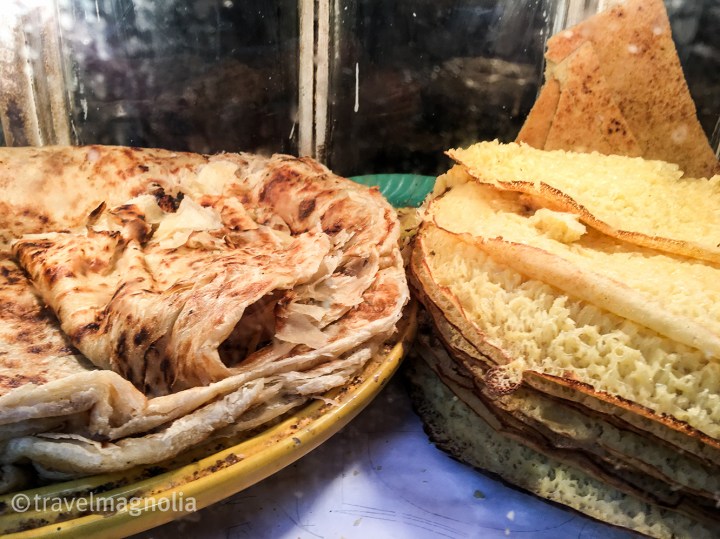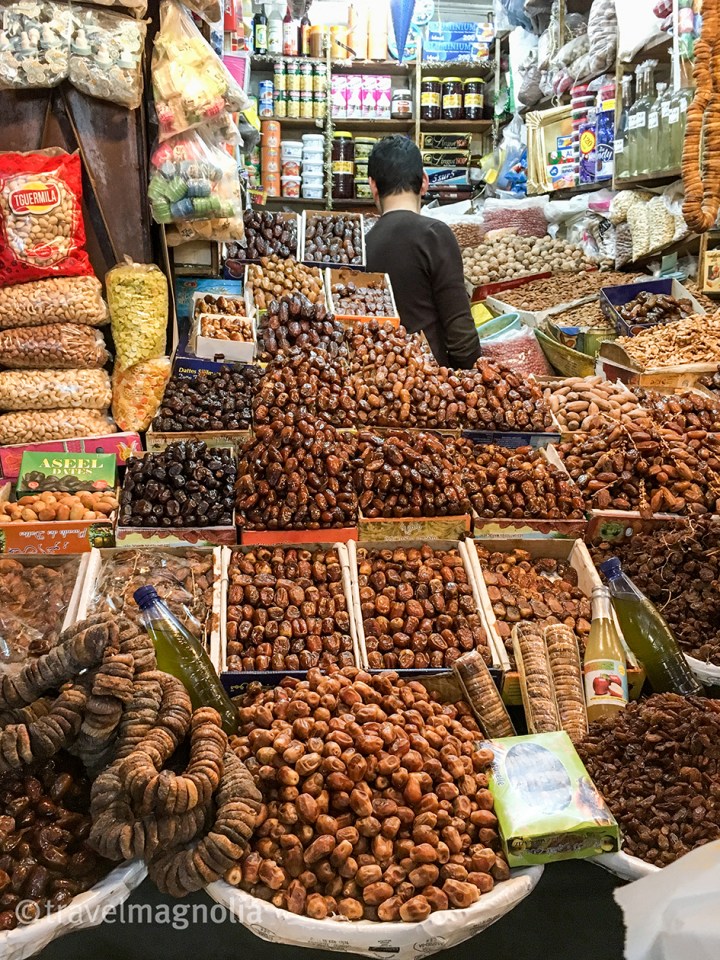While I loved staying at the Riad Fès and eating at a variety of restaurants, wandering the alleys of the medina with their mouthwatering displays did make me wish I could buy some provisions and cook a few meals — maybe next time!
Since we were there in springtime, the stalls were overflowing with the freshest produce in addition to everything else one could possibly need.

 This man alternated shelling fava beans with trimming the baby artichokes (I wish I could have brought some home!).
This man alternated shelling fava beans with trimming the baby artichokes (I wish I could have brought some home!). Herbs for use in tagines and if you can guess what the item is in the topmost basket…you are a lot smarter than I am! (Hint: it’s not edible but used after meals.)
Herbs for use in tagines and if you can guess what the item is in the topmost basket…you are a lot smarter than I am! (Hint: it’s not edible but used after meals.)

Rather than baking bread at home, people bring their bread to the communal baker.
 The aroma of fresh baked breads permeated the markets.
The aroma of fresh baked breads permeated the markets.

When my daughter studied in Fez, she came home raving about Maakouda sandwiches – a pocket bread stuffed with fried eggs, potato fritters (maakouda) and a spicy sauce. Once I ate the one above, I concurred with her assessment that it is the best sandwich in the world.
This woman must have teflon hands – and she seemed to average a sheet of phyllo every 20 seconds. No one makes phyllo at home anymore, since it can be ordered by weight or sheets and in staggering quantities for a wedding or other celebration.

There is an entire souk devoted to honey where we tasted over a dozen varieties. There were such distinct flavor profiles based on the bees’ diet. My personal favorites were cardamon, carob and thyme. I was not crazy about eucalyptus, cedar or caper. According to our guide, each of these honeys has a particular beneficial attribute: carob honey is good for digestion, while lavender honey is good for stress.

There are at least 45 distinct varieties of dates which are a favorite food for breaking the fast. I am not sure I have traveled to a country with a greater love for sweets.

There are stalls in the medina that sell other items year round, except for the month leading up to Ramadan when they sell pastries like these.

Tagine (or Tajine) refers to the terra cotta cookware used in preparing traditional Moroccan stews, as well as the glazed ceramics in which they are served, in addition to the dish itself. 
And, of course, there is the justly renowned Moroccan mint tea. Now that I have tasted mint tea the way it is supposed to be made, nothing else can compare.

Lastly, here is the “mystery” item in the basket above. It is dried Queen Anne’s Lace: each small branch is peeled off for use as a toothpick!


Yum – food heaven. How different to my past two weeks of Russian fare.
LikeLiked by 1 person
Russian! Where were you?
LikeLike
These Morocco posts have been fabulous! I’ve shared with a few friends. Wonderful! I just sent your old post on packing to a client too. Hope you’re well! XO > >
LikeLike
Thank you Diana! Hope to see you again soon!
LikeLike
On the next plane to Fez!
LikeLiked by 1 person
You won’t regret it! Wish I could click my heels…
LikeLike
by the way @rosejill, the top photo is in your honor!
LikeLike
LOVE this and I am so jealous of all the food! I particularly loved the phyllo video. So cool.
LikeLiked by 1 person
First heard about it from you!
LikeLike
Amazing! No wonder you wanted to buy everything in sight! And I never would have guessed what the Queen Anne’s lace was used for – that’s genius!
LikeLiked by 1 person
Amazing! My husband is Moroccan and I share a lot of recipes on my blog. You should check it out!
LikeLiked by 1 person
Thank you for stopping by! I will definitely visit your blog.
LikeLiked by 1 person